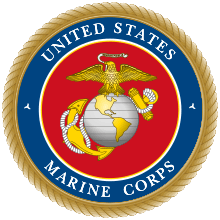VMO-7
Marine Observation Squadron 7 (VMO-7) was an observation squadron of the United States Marine Corps during World War II. They were active for a year and a half during which time they saw action during the Battle of Okinawa. The squadron was quickly deactivated following the end of the war.[1]
| Marine Observation Squadron 7 | |
|---|---|
| Active | December 15, 1944 – November 16, 1945 |
| Country | United States |
| Branch | USMC |
| Type | Observation squadron |
| Garrison/HQ | Inactive |
| Engagements | World War II * Battle of Okinawa |
History
VMO-7 was formed on December 15, 1944 at Marine Corps Base Quantico, Virginia. After a short period of training they moved to Marine Corps Air Station Ewa on February 27, 1945 sailing on board the British escort carrier HMS Ranee (D03).[2] Another two months of training in Hawaii saw them depart Pearl Harbor on April 17, 1945 and sail for Okinawa. The squadron filtered onto the island from 7 – 11 May and quickly began flights spotting targets for III Amphibious Corps’ artillery. During the period between June 11 to June 22 the squadron made 271 CASEVAC flights from a dirt strip in Naha taking 369 casualties[3] back to hospitals in the rear areas.[4] They were engaged in combat operation on Okinawa until June 21, 1945. During the battle the squadron flew 300 combat hours without losing a pilot or plane.[5] They remained on the island for the rest of the war and were deactivated on November 16, 1945
Awards


See also
- United States Marine Corps Aviation
- List of United States Marine Corps aircraft squadrons
References
- Notes
- Sherrod ‘’History of Marine Corps Aviation in World War II.’’ p. 453.
- Sherrod ‘’History of Marine Corps Aviation in World War II.’’ p. 378.
- Sherrod ‘’History of Marine Corps Aviation in World War II.’’ p. 378.
- De Chant, John Devilbirds p. 242.
- Sherrod ‘’History of Marine Corps Aviation in World War II.’’ p. 378.
- Bibliography
- De Chant, John A. (1947). Devilbirds - The Story of United States Marine Aviation in World War II. New York: Harper & Brothers.
- Sherrod, Robert (1952). History of Marine Corps Aviation in World War II. Washington, D.C.: Combat Forces Press.
- Web
